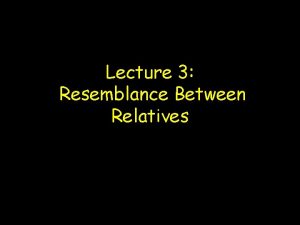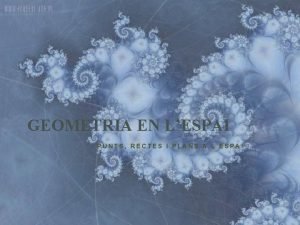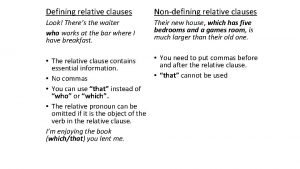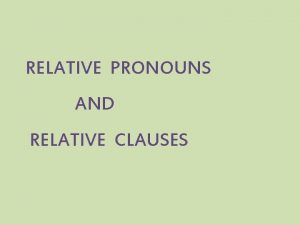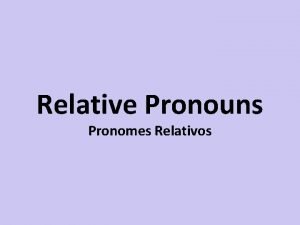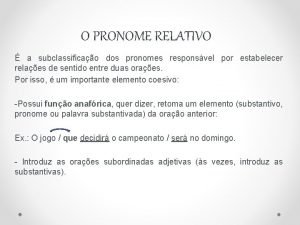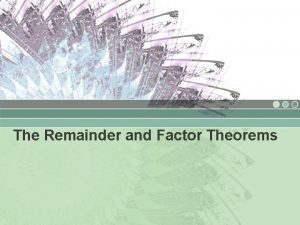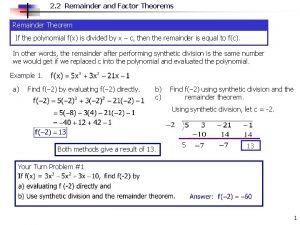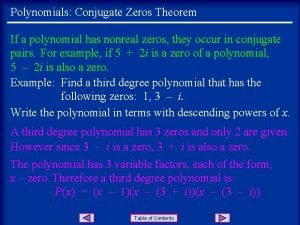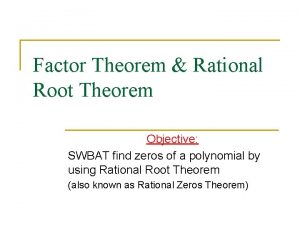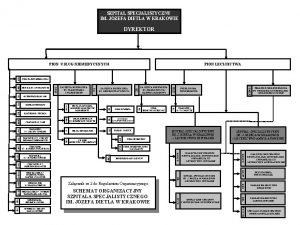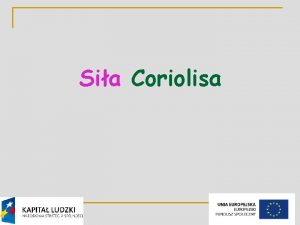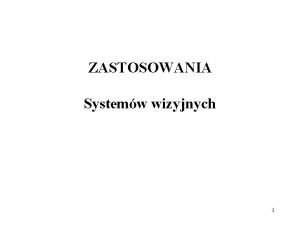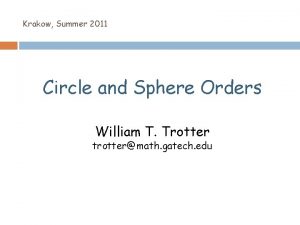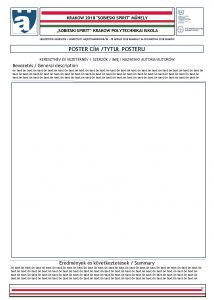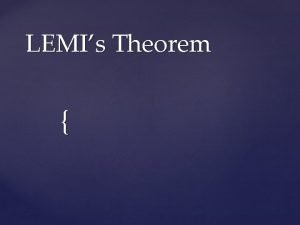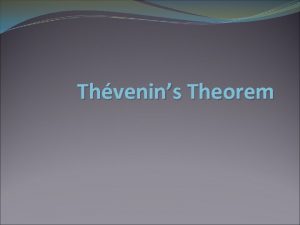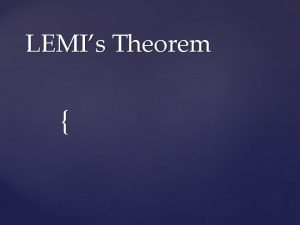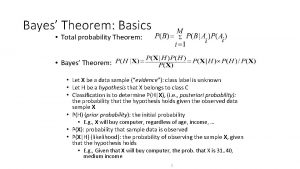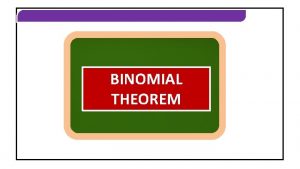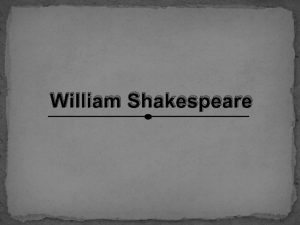Krakow Summer 2011 Schnyders Theorem and Relatives William






















































- Slides: 54

Krakow, Summer 2011 Schnyder’s Theorem and Relatives William T. Trotter trotter@math. gatech. edu

The Dimension of a Poset L 1 = b < e < a < d < g < c < f L 2 = a < c < b < d < g < e < f L 3 = a < c < b < e < f < d < g The dimension of a poset is the minimum size of a realizer. This realizer shows dim(P) ≤ 3. In fact, dim(P) = 3

A Modest Question Why should someone whose primary focus is graph theory be at all interested in the subject of dimension for partially ordered sets?

Incidence Posets

Triangle Orders

Alternate Definition Exercise A poset has dimension at most 3 if and only if it is a triangle order.

Schnyder’s Theorem (Schnyder, 1989) A graph is planar if and only if the dimension of its incidence poset is at most 3.

Easy Direction (Babai and Duffus, 1981) Suppose the incidence poset has dimension at most 3.

Easy Direction - 2 There are no non-trivial crossings. It follows that G is planar.

Schnyder’s Theorem – The Hard Part Theorem (Schnyder, 1989) If G is planar, then the dimension of its incidence poset is at most 3. Without loss of generality, G is maximal planar, i. e. , G is a triangulation.

Outline for the Hard Part Schnyder labelings of rooted planar triangulations. Uniform angle lemma. Directed paths witnessing 3 -connectivity. Explicit decomposition of edges into 3 forests. Inclusion property for regions. Three auxiliary partial orders. Linear extensions determine a realizer of P.

Schnyder Labeling of a Triangulation

Each interior face The angles of each interior triangle are labeled in clockwise order 0, 1 and 2.

Each Exterior Vertex For each i = 0, 1, 2, all angles incident with exterior vertex vi are labeled i.

Each Interior Vertex For each interior vertex x, the angles incident with x are labeled in clockwise order as a non-empty block of 0’s, followed by a non-empty block of 1’s and then a nonempty block of 2’s.

Schnyder Labelings Exist Lemma Every rooted planar triangulation admits a Schnyder labeling.

Schnyder Labeling of a Triangulation

Case 1: Separating Triangle

Remove Separating Triangle

Case 2: No Separating Triangles The neighbors of v 0 form a path from v 1 to v 2. The only chord on this path is the edge v 1 v 2. Choose a neighbor x of v 0, distinct from v 1 and v 2. Then contract the edge v 0 x

Uniform Angles on a Cycle Uniform 0 Uniform 2 Uniform 1

Uniform Angle Lemma If T is a rooted planar triangulation, C is a cycle in T, and L is a Schnyder labeling of T, then for each i = 0, 1, 2, there is a uniform i on C.

Cycles and Uniform Angles

Suppose C has no Uniform 0 Suppose C is the smallest cycle (in terms of the number of enclosed faces) for which there is some i so that C does not contain a uniform i. Without loss of generality, we assume C has no uniform 0.

Case 1: C has a Chord Both the top part and the bottom part have uniform 0’s, so they must occur where the chord cuts the cycle C.

Uniform 0 on Top Part We assume first that the uniform 0 in the top part occurs in the left corner as shown (the argument is dual in the other case).

Uniform 0 on Bottom Part The uniform 0 in the bottom part must then be in the right corner.

The Contradiction Consider the two triangle faces that are incident with the chord. Their clockwise labeling results in violations of the consecutive block property at the endpoints of the chord.

Case 2: C has No Chords For every edge e = xy on the cycle C, there is a vertex z interior to C so that xyz is a triangle face.

Remove a Boundary Edge The remaining cycle has fewer faces, so it has a uniform 0. This angle must be incident with the edge that has been removed.

Without Loss of Generality We assume first that the uniform 0 is on the left, as shown. Again, the other case is dual.

Continue Around Cycle The argument continues around the cycle until all triangles incident with boundary edges are labeled as shown.

The Contradiction Now remove any edge from C. The smaller cycle does not have a uniform 2.

Three Special Edges Each interior vertex has three special edges leading to distinguished neighbors.

Orienting the Interior Edges Each interior edge has two common labels on one end and two differing labels on the other. This defines an orientation of all interior edges.

Red Path from an Interior Vertex

Red Path from an Interior Vertex

Red Cycle of Interior Vertices? ? Such a cycle cannot occur because it would violate the Uniform Angle Lemma.

Red Path Ends at Exterior Vertex v 0

Red and Green Paths Intersect? ? Two paths from an interior vertex cannot intersect, as this would again violate the Uniform Angle Lemma.

Three Paths and Three Regions For each interior vertex x, the three pairwise disjoint paths to the exterior vertices determine three regions S 0(x), S 1(x) and S 2(x).

Inclusion Property for Regions For each i = 0, 1, 2, if y is in Si(x), then Si(y) is contained in Si(x).

Explicit Partition into 3 Forests

Final Steps The regions define three inclusion orders on the vertex set. Take three linear extensions. Insert the edges as low as possible. The resulting three linear extensions have the incidence poset as their intersection. Thus, dim(P) ≤ 3.

Grid Layouts of Planar Graphs

Labelings Determine Embeddings Corollary (Schnyder, 1990) For each interior vertex x and each i = 0, 1, 2, let fi denote the number of faces in region Si(x). Then place vertex x at the grid point (f 1, f 2) to obtain a grid embedding without edge crossings.

The Partial Orders Separate Edges Lemma The three partial orders “separate” edges. If e = xy and f = zw are edges with no common end points, then there is some i for which either: x, y > z, w in Pi or z, w > x, y in Pi.

Algebraic Structure for Labelings Theorem (de Mendez, 2001) The family of all Schnyder labelings of a rooted planar triangulation forms a distributive lattice.

3 -Connected Planar Graphs Theorem (Brightwell and Trotter): If G is a planar 3 -connected graph and P is the vertex-edge-face poset of G, then dim(P) = 4. Furthermore, the removal of any vertex or any face from P reduces the dimension to 3.

Convex Polytopes in R 3

Vertex-Edge-Face Posets

Convex Polytopes in R 3 Theorem (Brightwell and Trotter, 1993): If M is a convex polytope in R 3 and P is its vertex-edge-face poset, then dim(P) = 4. Furthermore, the removal of any vertex or face from P reduces the dimension to 3.

Planar Multigraphs

Planar Multigraphs Theorem (Brightwell and Trotter, 1993): Let D be a non-crossing drawing of a planar multigraph G, and let P be the vertex-edge-face poset determined by D. Then dim(P) ≤ 4. Different drawings may determine posets with different dimensions.
 Difference between green's theorem and stokes theorem
Difference between green's theorem and stokes theorem Chapter 26 section 2 arthropod diversity
Chapter 26 section 2 arthropod diversity Phylum polypodiophyta
Phylum polypodiophyta Bryophytes include
Bryophytes include Resemblance between relatives
Resemblance between relatives Punts coplanaris
Punts coplanaris Relatives risiko interpretation
Relatives risiko interpretation Non defining relatives clauses
Non defining relatives clauses Prepositions in relative clauses
Prepositions in relative clauses Life cycle of a wolverine
Life cycle of a wolverine Poseidon clothes
Poseidon clothes Ferret relatives
Ferret relatives Kibe bryant kids
Kibe bryant kids Carrot bulb
Carrot bulb Oracions relatives
Oracions relatives Napoleon bonaparte dominated
Napoleon bonaparte dominated Pronomes enfaticos
Pronomes enfaticos Hadith images
Hadith images Pronome relativa
Pronome relativa The closest algal relatives of land plants are
The closest algal relatives of land plants are Price relatives
Price relatives Nokia solutions and networks kraków
Nokia solutions and networks kraków Boat stealing poem analysis
Boat stealing poem analysis The prelude boat
The prelude boat What is factor theorem
What is factor theorem Factor theorem and remainder theorem
Factor theorem and remainder theorem Remainder theorem
Remainder theorem Conjugate zeros theorem
Conjugate zeros theorem Rational root theorem and factor theorem
Rational root theorem and factor theorem Linear factors theorem and conjugate zeros theorem
Linear factors theorem and conjugate zeros theorem Rytmy do defibrylacji
Rytmy do defibrylacji Biblioteka wojewódzka kraków
Biblioteka wojewódzka kraków Mapa hałasu kraków
Mapa hałasu kraków Wciągnięte brodawki kraków
Wciągnięte brodawki kraków Inicjatywa mikro
Inicjatywa mikro U pana cogito
U pana cogito Federal benefit unit
Federal benefit unit Prc.krakow.pl
Prc.krakow.pl Oke kraków obieg
Oke kraków obieg Kraków dawna stolica polski
Kraków dawna stolica polski Prc kraków
Prc kraków Rda.krakow.pl
Rda.krakow.pl Zse2 krakow
Zse2 krakow Szpital dietla kraków dyrekcja
Szpital dietla kraków dyrekcja Rada resuscytacji wytyczne
Rada resuscytacji wytyczne Compair kraków
Compair kraków Mpp kraków
Mpp kraków Sutura krakow
Sutura krakow Na półkuli północnej pasaty przyjmują kierunek
Na półkuli północnej pasaty przyjmują kierunek Jcj lektoraty
Jcj lektoraty Ogród jordanowski kraków
Ogród jordanowski kraków Systemy wizyjne kraków
Systemy wizyjne kraków Zielarstwo i fitoterapia studia 1 stopnia
Zielarstwo i fitoterapia studia 1 stopnia National population and housing census 2011
National population and housing census 2011 Gleitman gross and reisberg 2011
Gleitman gross and reisberg 2011




